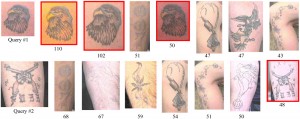
A report came out on how some Computer Science Majors at Michigan State University Anil Jain and Jung-Eun Lee have created a computer system for law enforcement called Tattoo ID. Tattoo ID is a system that allows police to do more than a traditional search by keyword, using characteristics of the tattoo such as color, shape, and texture to identify the tattoo. Before you start panicking and getting all your tattoos removed, at the end of the day they are simply creating an “Advanced Search Feature”. Some more details of what they are doing after the jump…
To efficiently and accurately match tattoo images, we have created an automatic system called Tattoo-ID. Our approach is one of content-based image retrieval using features (e.g., color, shape, and texture), instead of labels or keywords, to compute the similarity between two images. Given a query, Tattoo-ID retrieves the top-N (say, N=20) images in the database that visually resemble it, and presents them to the user in order of similarity. ‘User feedback’ or ‘preference’ based on retrieved images could be used to improve both feature extraction and the similarity measure of the matching module. To keep our system compatible with current practice in law enforcement, Tattoo-ID also employs class and subclass labels. In other words, a user can specify both the tattoo image and its ANSI/NIST category information as part of the query. The current version of our system uses scale-invariant feature transformation6 to extract characteristic ‘keypoints’ from a tattoo image and to represent the image using descriptors (vectors) associated with the points. Matching is then performed by comparing the descriptors in two images. The Tattoo-ID system currently contains 64,000 tattoo images (courtesy of the Michigan State Police). Keypoints extracted from these images are stored into the database. In the matching and retrieval stages, users provide a tattoo image with optional ancillary information such as labels and location of the tattoo on the body. Initial results based on 1000 queries against the full database show 83.5% rank-1 and 91.2% rank-20 retrieval accuracies. In other words, 835 out of 1000 queries found a true match in the first image returned out of a database of 64,000. Similarly, 912 queries were correctly answered from among the first 20 images retrieved.